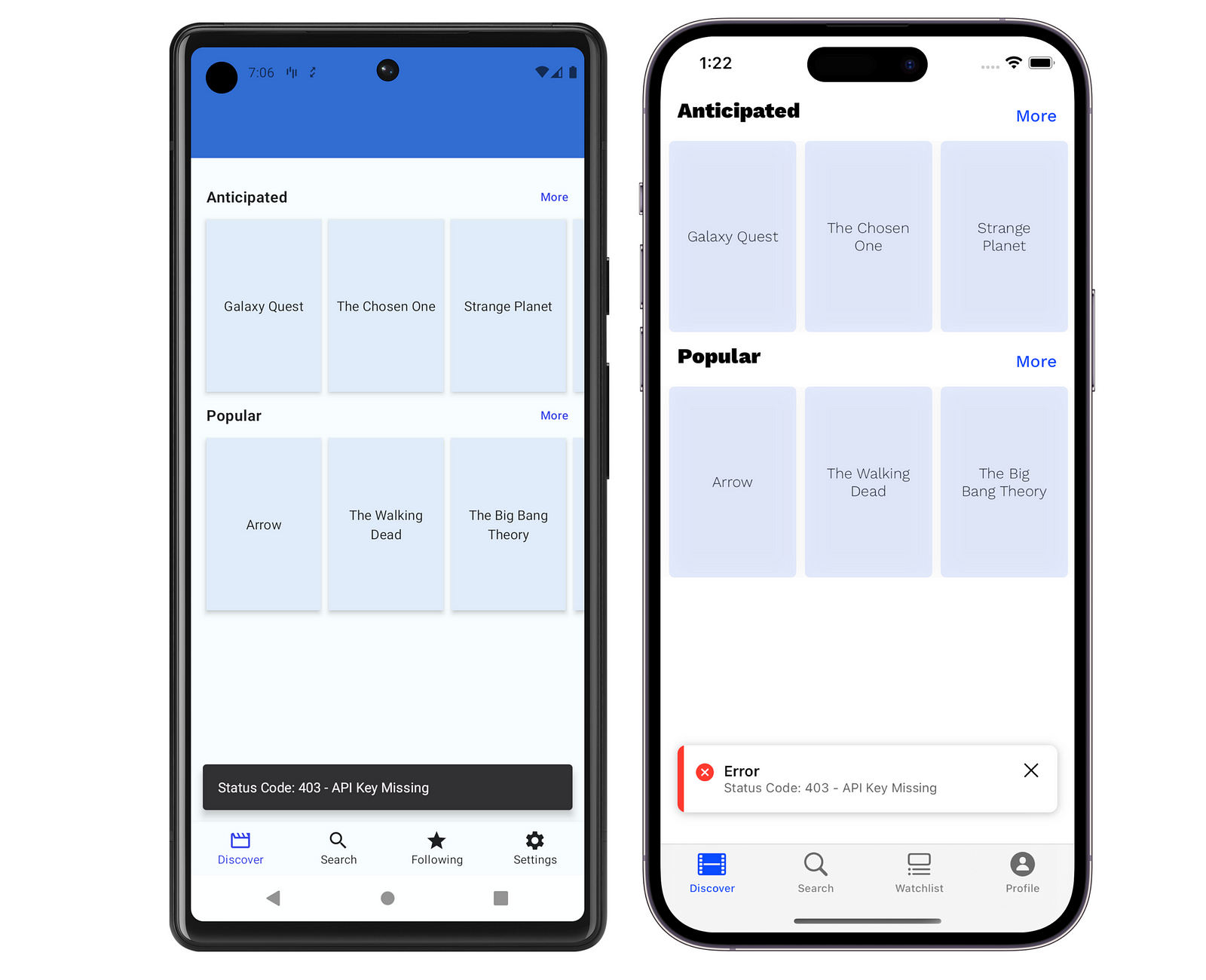
Introduction:
Handling various HTTP response codes is crucial when building mobile applications that communicate with APIs. This article will explore how to use Ktor’s HttpResponseValidator to intercept and handle responses in mobile applications.
We’ll use Trakt as a use case since it’s what I am for my project, but the concept should work for any API. One of the status codes from Trakt is 403 (Forbidden), which indicates that the server understands the request but refuses to authorize it. We’ll see how we can intercept such responses, format the message and present this to the user.
Below is what we’ll be able to achieve at the end of this. 😎

TL;DR
If you just want to look at the code, click the link below.
Ktor Error Handling by c0de-wizard · Pull Request #95 · c0de-wizard/tv-maniac
_Description Implement HttpResponseValidator and intercept network responses. Previously we just showed an empty screen…_github.com
Understanding HttpResponseValidator
Ktor is a robust Kotlin-based framework for building server-side and client-side applications. It provides a flexible and extensible architecture to efficiently handle HTTP requests and responses. One of the key components in Ktor is the HttpResponseValidator, which allows developers to define a custom response.
when (statusCode) {
in 300..399 -> throw RedirectResponseException(response)
in 400..499 -> throw ClientRequestException(response)
in 500..599 -> throw ServerResponseException(response)
}
Intercepting Responses
To intercept responses, we need to add HttpResponseValidator inside the HttpClient’s body Ktor’s to check the response’s status code and take appropriate action. Before doing that, we need to enable default validation by setting the expectSuccess property to true. This terminates HttpClient.receivePipeline if the status code is unsuccessful.
HttpClient(httpClientEngine) {
expectSuccess = true
...
HttpResponseValidator {
validateResponse { response ->
if (!response.status.isSuccess()) {
val httpFailureReason = when (response.status) {
HttpStatusCode.Unauthorized -> "Unauthorized request"
HttpStatusCode.Forbidden -> "${response.status.value} Missing API key" HttpStatusCode.NotFound -> "Invalid Request"
HttpStatusCode.UpgradeRequired -> "Upgrade to VIP"
HttpStatusCode.RequestTimeout -> "Network Timeout"
in HttpStatusCode.InternalServerError..HttpStatusCode.GatewayTimeout ->
"${response.status.value} Server Error"
else -> "Network error!"
}
throw HttpExceptions(
response = response,
cachedResponseText = response.bodyAsText(),
httpFailureReason = httpFailureReason,
)
}
}
}
}
Here’s our custom exception class.
class HttpExceptions(
response: HttpResponse,
failureReason: String?,
cachedResponseText: String,
) : ResponseException(response, cachedResponseText) {
override val message: String = "Status: ${response.status}." + " Failure: $failureReason"
}
API Response Wrapper
With the HttpResponseValidator in place, we can create an extension function to wrap API responses.
suspend inline fun <reified T, reified E> HttpClient.safeRequest(
block: HttpRequestBuilder.() -> Unit,
): ApiResponse<T, E> =
try {
val response = request { block() }
ApiResponse.Success(response.body())
} catch (exception: ClientRequestException) {
ApiResponse.Error.HttpError(
code = exception.response.status.value,
errorBody = exception.response.body(),
errorMessage = "Status Code: ${exception.response.status.value} - API Key Missing",
)
} catch (exception: HttpExceptions) {
ApiResponse.Error.HttpError(
code = exception.response.status.value,
errorBody = exception.response.body(),
errorMessage = exception.message,
)
} catch (e: SerializationException) {
ApiResponse.Error.SerializationError(e.message)
} catch (e: Exception) {
ApiResponse.Error.GenericError(e.message)
}
You can also use kotlin-result or Arrow’s Either depending on your needs. In this case, we will create our class. ApiResponse
sealed class ApiResponse<out T, out E> {
/**
* Represents successful network responses (2xx).
* */
data class Success<T>(val body: T) : ApiResponse<T, Nothing>()
sealed class Error<E> : ApiResponse<Nothing, E>() {
/**
* Represents server errors.
* @param code HTTP Status code
* @param errorBody Response body
* @param errorMessage Custom error message
*/
data class HttpError<E>(
val code: Int,
val errorBody: String?,
val errorMessage: String?,
) : Error<E>()
/**
* Represent SerializationExceptions.
* @param message Detail exception message
* @param errorMessage Formatted error message
*/
data class SerializationError(
val message: String?,
val errorMessage: String?,
) : Error<Nothing>()
/**
* Represent other exceptions.
* @param message Detail exception message
* @param errorMessage Formatted error message
*/
data class GenericError(
val message: String?,
val errorMessage: String?,
) : Error<Nothing>()
}
}
API Requests
We can now create a function with a return type ApiResonse<T> and use the extension function we created to make the API call.
override suspend fun getPopularShows(
page: Long
): ApiResponse<List<TraktShowResponse>, ErrorResponse> =
httpClient.safeRequest {
url {
method = HttpMethod.Get
path("shows/popular")
}
}
You can now invoke the Api call and handle the response based on your implementation. In my case, I am using Store5. (Blog coming soon). We make the API call inside the fetcher. If successful, cache it else, throw an exception.
{
...
fetcher = Fetcher.of {
val apiResponse = remoteDataSource.getPopularShows(page = 1)
when (apiResponse) {
is ApiResponse.Success -> {
// Map and cache data to local-source.
}
is ApiResponse.Error.HttpError -> throw Throwable("${response.errorMessage}")
is ApiResponse.Error.GenericError -> throw Throwable("${response.errorMessage}")
is ApiResponse.Error.SerializationError -> throw Throwable("${response.errorMessage}")
}
}
By doing this, Store will wrap the exception in the StoreReadResponse.Error type, ensuring the flow does not break the stream and will still receive updates when data changes. We can now propagate the result and handle it in the presentation layer. In this case, when we get an exception, we show a SnackBar.
And that’s it! 🎊